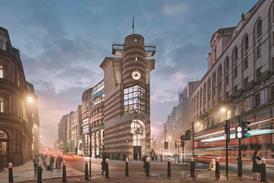- Home
- Intelligence for Architects
- Subscribe
- Jobs
- Events

2025 events calendar Explore now 
Keep up to date
Find out more
- Programmes
- CPD
- More from navigation items
BD Film Club: Empire of Light revisited

In the first of a new occasional series, Yufei Li takes a look back at Sam Mendes’ 2022 film and its themes of love, longing, and the bittersweet passage of time, all set against a backdrop of Margate’s faded seafront
Empire of Light (2022), the most recent cinematic offering from director Sam Mendes, is a mesmerising journey through the human condition, illuminated by the flickering seashore lights. Set against the backdrop of 1980s England, specifically the quaint seaside town of Margate, Mendes skilfully crafts a narrative that not only explores love, longing, and the bittersweet passage of time but also intimately connects with the nostalgic charm of Margate and its iconic Dreamland amusement park.
The choice of Margate as the film’s actual shooting location infuses the narrative with a sense of place and history that is both tangible and evocative. From the windswept beaches to the bustling promenade, with the vibrant neon lights of the arcade or the gentle lapping of the waves against the shore, the sights and sounds of the town come alive on screen, enveloping the audience in a world that is at once familiar and enchanting. Dreamland, with its vintage rides and faded grandeur, serves as a metaphor for the fleeting nature of happiness and the relentless march of time. As the characters navigate the winding pathways of the amusement park, they are also navigating the complexities of their own lives, their hopes and dreams mirroring the faded glory of the seaside town itself.
…
This content is available to registered users | Already registered?Login here
You are not currently logged in.
To continue reading this story, sign up for free guest access
Existing Subscriber? LOGIN
REGISTER for free access on selected stories and sign up for email alerts. You get:
- Up to the minute architecture news from around the UK
- Breaking, daily and weekly e-newsletters
Subscribe to Building Design and you will benefit from:

- Unlimited news
- Reviews of the latest buildings from all corners of the world
- Technical studies
- Full access to all our online archives
- PLUS you will receive a digital copy of WA100 worth over £45
Subscribe now for unlimited access.






